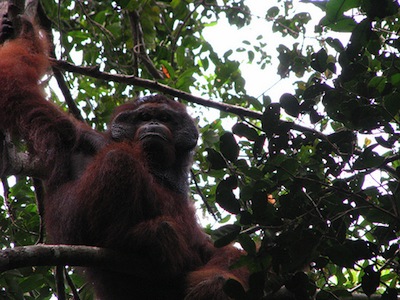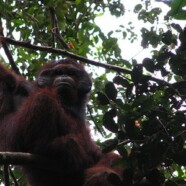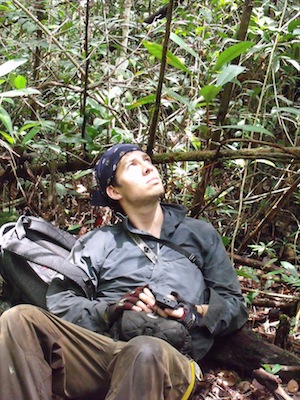Call of the Orangutan: An Expedition to Indonesia
This week I’ll swap the traffic and sunshine of Los Angeles for the rainforests of Indonesia, where I’ll be living for the next 18 months. The reason for my long trip is to collect data for my PhD dissertation studying orangutans, and I’m excited to be writing this expedition blog which I hope will give you all an insight into my life as a (very junior) field primatologist studying the world’s most threatened ape, along with my thoughts and experiences from working in the confusing and contradictory, but ultimately incredible Indonesia.
My research is focused on the function of the orangutan long call in intersexual relationships. The long call is a loud, long-distance vocalization (which can travel up to a kilometer depending on the weather conditions and topography), typically produced by flanged-males who use their fatty cheek pads and throat sacs like a bullhorn to amplify and direct the call. These guys are big, weighing as much as 115 kilograms, so watching an individual pull himself up high in the branches before unleashing his call in a minutes-long, violent display of branch shaking and even pushing over trees is one of the most impressive things I’ve ever seen!
While studying one specific vocalization sounds very narrow, because adult orangutans rarely come into contact with another, yet maintain social and reproductive relationships, the long call potentially plays a vital role in orangutan society. Identifying the function of the long call and its socio-ecological correlates, my aim is to provide a more nuanced understanding of orangutan social structure and mating strategies across the different populations. Additionally, the data I collect and the novel methods I’m using (including an array of different technologies I’m really excited to try) will also be readily applicable to broader questions and future research in fields as diverse as evolutionary biology, anthropology, conservation biology and perhaps even linguistics.
Working out the function, or purpose, of animal communication is difficult. We can’t just ask them what they’re “saying.” Consequently, I’m planning to address my question in two ways. Firstly, using acoustic analyses, along with a range of morphological and physiological measures, I’m going to identify what information is being encoded in the males’ calls – are they reflective of dominance, size, age, hormone levels or individual identity, or are they context specific? Secondly, using playback experiments, physiological measures and focal follows (basically, I follow an animal and record its behavior every two minutes from when it wakes up until it makes a nest and goes to sleep, and then repeat until I can’t handle it any more!), I’m going to identify how females are using this information and how their behavior depends on their reproductive status along with the “calling” male’s characteristics. Getting this information will be a challenge, and in future posts I’ll go into greater detail about the different equipment and methods I’ll be using.

Peter Pan, a flanged male orangutan, surveys researchers in the Sabangau Forest (credit: James Askew)
Orangutans, like humans, are incredibly flexible in their behavior, maintaining different social structures and mating systems depending on the habitat in which they live and the demographics of a given population. As a result, my study is going to compare three different sites, each with their own distinct characteristics and populations of orangutans. For the first six months I’ll be working with the Sumatran Orangutan Conservation Project (SOCP) based in the Gunung Leuser National Park at the new Sikundur monitoring station. I’m very excited to study members of the Sumatran species (Pongo abelii) as they are typically characterized as having a very different social structure and reproductive strategies than their Bornean counterparts, and this is my first time working on the island. I’ve also been told (by Sumatran based researchers) that they’re a lot “prettier.” (I still need to be convinced.)
My second site will be at the Sabangau Forest in Central Kalimantan (Borneo), where I’ll be working with the Orangutan Tropical Peatland Project. Sabangau is where I completed my master’s degree research in 2010, and it was my first experience studying wild Bornean orangutans (Pongo pygmaeus wurmbii). As hinted at by OuTrop’s name, the habitat is peat-swamp, meaning primary rainforest trees standing on a 10 to 15-meter layer of peat (partially decayed and waterlogged plant material), which guarantees I’ll spend most days soaking wet! However, despite the swamp, the forest is also home to the largest remaining population of orangutans (estimated ~6,900), making it an excellent choice for research. Finally, I’ll finish up at the Prevab Camp in Kutai National Park in East Kalimantan. This site contains the least studied sub-species of orangutans (Pongo pygmaeus morio; although see the Kutai Orangutan Project), and I’m hopeful, based on a pilot study I ran in 2012, that there should be a number of reproductively active females when my study comes around – a rarity given orangutans long interbirth intervals of 6 to 9 years.
One thing all orangutan research sites have in common is high human disturbance. Two of my sites are former logging concessions and the third (also extensively logged) is close to the world’s second largest coal mine in Sangatta. This manmade destruction is very much inescapable when working with orangutans, so my hope is that through the behavioral studies, nest surveys, phenology sampling and novel monitoring methods I’m going to try, I can help aid research into how this critically endangered animal responds to extensive habitat loss and degradation, thus helping to guide future conservation efforts. Personally, I feel the most critical aspect of conserving the Bornean rainforest is capacity building. To this end, working with the two fantastic NGOs (SCOP and OuTrop) provides a great opportunity to integrate my research with local stakeholders such as national park staff, my collaborator universities in Indonesia, and local people. One of the best things about my job is getting to work with and train Indonesian field assistants and students, and I look forward to introducing you to these awesome people who will become my friends and colleagues over the coming year and a half.
Right now the prospect of moving for such a long time seems a little daunting. I’m sure the next 18 months will be a blur of government bureaucracy, 100 percent humidity, early mornings, long treks, homesickness, tropical diseases, giant insects, broken equipment and, of course, “misbehaving” animals (and I had to cut this list in half!). Ultimately though, I cannot wait to get back for the amazing people, incredible food and diverse culture (including one of the most interesting languages I’ve encountered: Bahasa Indonesia). But mostly what I love, and want to share with you, is the excitement of “field life” – spending all day with the most amazing, intelligent and entertaining animals before returning to camp at night with field assistants and other researchers, all of which is set in the most beautiful jungle imaginable. Nothing matches the feeling I get walking out into the forest at 5 a.m. I want more sleep, my boots hurt, my clothes will probably never be clean again, and then the gibbons start singing in the mist.
It’s going to be an amazing 18-months, and I can’t wait to share it with you.
About the Author: James Askew is a PhD candidate in Integrative and Evolutionary Biology at the University of Southern California Jane Goodall Research Center. His research is focused on orangutan behavior, specifically the “long call” and its role in social and reproductive relationships. Over the next 18 months he will be running a comparative study of three different populations at sites in Borneo and Sumatra.


